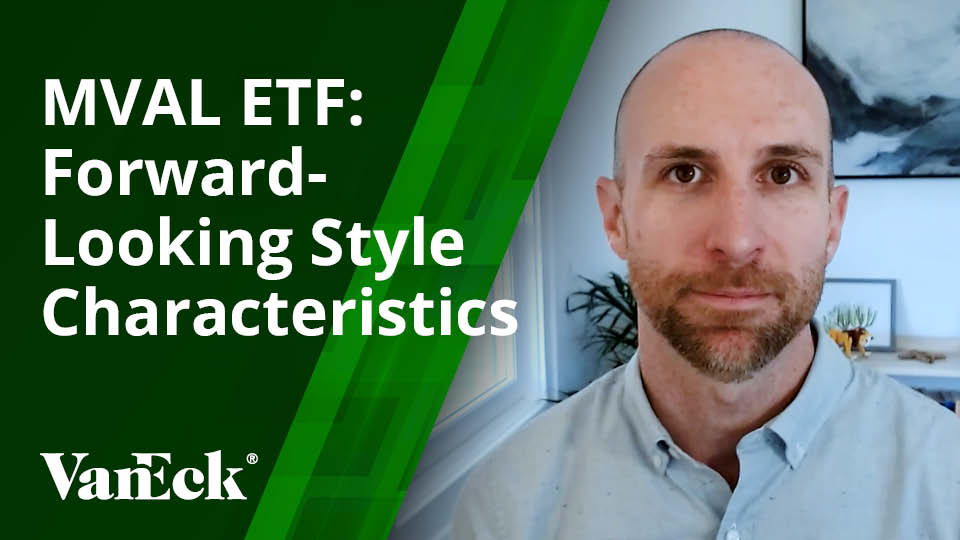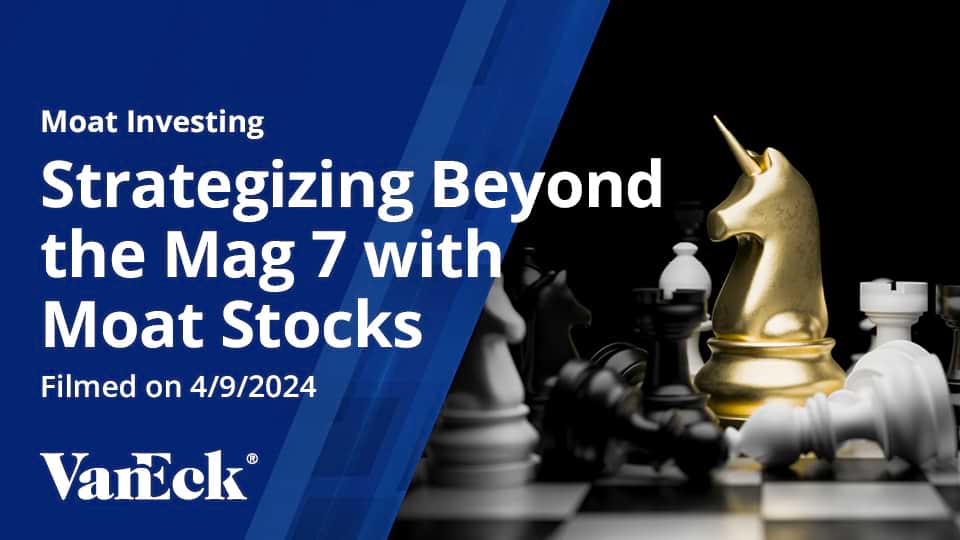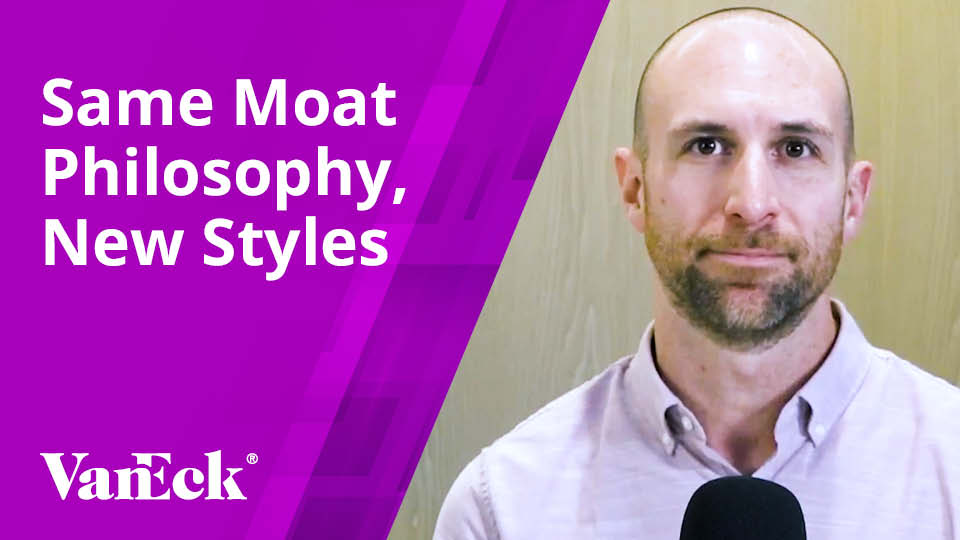Build a Better Core. Don’t Fall In and Out of Style.
October 19, 2022
Watch Time 6:19 MIN
Jenna Dagenhart: Joining us now to talk about VanEck’s moat investing strategy is Brandon Rakszawski, VP and Director of Product Management at VanEck. Brandon, great to have you back with us.
Brandon Rakszawski: It's great to be back. Thanks for having me.
Jenna Dagenhart: Brandon, MOAT’s investment strategy is driven by Morningstar's equity research, and as the name implies, they're focused on economic moats. Can you tell us about moat ratings and why they're important?
Brandon Rakszawski: That's right. The VanEck Morningstar Wide Moat ETF (Ticker: M-O-A-T) tracks an index from Morningstar—the Morningstar Wide Moat Focus Index—which as the name implies, is fully focused on wide moat companies.
Now, moat companies are important, because these companies have been identified amongst a broad array of U.S. equities as companies that have established a competitive advantage—one that is strong but also sustainable well into the future. And this concept of economic moats really serve as the foundational element of Morningstar's equity research.
Jenna Dagenhart: MOAT also considers valuations. Of course, Brandon, could you share a little bit more about how it incorporates valuations into the investment process?
Brandon Rakszawski: That's right. Valuations, we have found, are really critical. As I alluded to, a lot of people want to own great companies. If a company is a well-run sound business, most investors may seek out exposure to that particular company, so you may have to pay a premium to own great companies. That's just the reality. If you can buy great companies that may be mispriced at the time, that is when you can really position a portfolio for potential success.
That's what this particular strategy does. It's another aspect of Morningstar’s equity research that is leveraged by this index-based strategy in a systematic way. In the same way that Morningstar equity research analysts are assigning an economic moat rating to measure and assess the company's competitive advantage and profitability prospects, Morningstar equity research analysts are also using that information to inform their valuation assessment of a company. They are forecasting those company's future free cash flow well into the future, discounting those back to today to determine a current intrinsic value for a company.
But when you add that valuation element that's where you can see the most success. And we have seen the most success in terms of outperformance versus the broad U.S. equity market. The S&P 500, for example, over long periods of time, 5-10 year time periods, this strategy had delivered more often than not excess returns relative to the broad market.
Jenna Dagenhart: Finally given the current environment, Brandon, how are advisors using MOAT?
Brandon Rakszawski: We've talked with many, many advisors over the years. MOAT has been in the market for 10 years. Its underlying index has been live for 15+ years. And the ETF has grown and now currently sits above $6B in assets despite the market turmoil we've lived through over the last six to nine months. And we found that advisors use MOAT in a couple of different ways.
Those that are open to core allocations outside of cheap beta allocations have very much looked to MOAT as a core U.S. equity position in their clients’ portfolios for the reasons I outlined—those excess returns that the strategy has historically delivered over long periods of time.
The strategy is able to target mispriced companies on a regular basis, very frequently, quarterly through its index review process. The index has historically also been able to exploit or take advantage of market turmoil and oftentimes can position itself to participate and sometimes often participate in a bigger way in market recovery.
We've seen advisors looking at the strategy now, trying to understand where those allocations have shifted over the last 9-12 months. And one last point that's actually I found very interesting is you have advisors that simply will stick to beta for their core.
They may even have an active manager that they've used for a very long period of time and have delivered successful returns in that core U.S. equity category. But they may look to a value manager or a growth manager and dial up their client’s exposure to value or growth.
Well, what MOAT can do, because it's style agnostic, it will essentially allocate to the areas of the U.S. large-cap market that are signaling valuation opportunities within that wide moat equity universe.
The strategy will shift from value to growth, and we've actually seen a little bit of a growth posture developed over the last 3-6 months as more and more evaluation opportunities have become available within the growth space.
Advisers looking at this strategy from the core aspect as well as using it to handle those style-based decisions for U.S. equity.
Jenna Dagenhart: Well, Brandon, always great to have you. Thanks for joining us.
Brandon Rakszawski: My pleasure, thank you for having me.
Jenna Dagenhart: And thank you for watching. Once again, that was Brandon Rakszawski, VP and Director of Product Management at VanEck. I'm Jenna Dagenhart with Asset TV, and to learn more you can visit vaneck.com/subscribe.
IMPORTANT DISCLOSURE
Please note that VanEck may offer investments products that invest in the asset class(es) or industries included in this webinar.
The views and opinions expressed are those of the speaker and are current as of the video’s posting date, and are not necessarily those of VanEck or its employees. Video commentaries are general in nature and should not be construed as investment advice. References to specific securities and their issuers or sectors are for illustrative purposes only. This is not an offer to buy or sell, or a recommendation to buy or sell any of the securities/financial instruments mentioned herein. The information presented does not involve the rendering of personalized investment, financial, legal, or tax advice. Certain statements contained herein may constitute projections, forecasts and other forward looking statements, which do not reflect actual results, are valid as of the date of this communication and subject to change without notice. Information provided by third party sources are believed to be reliable and have not been independently verified for accuracy or completeness and cannot be guaranteed. VanEck does not guarantee the accuracy of third party data.
Index returns are not Fund returns and do not reflect any management fees or brokerage expenses. Certain indices may take into account withholding taxes. Investors cannot invest directly in the Index. Index returns assume that dividends have been reinvested. The Morningstar Wide Moat Focus Index was created and is maintained by Morningstar, Inc. Morningstar, Inc. does not sponsor, endorse, issue, sell, or promote the VanEck Wide Moat ETF and bears no liability with respect to that ETF or any security. Morningstar is a registered trademark of Morningstar, Inc. Morningstar Wide Moat Focus Index is a service mark of Morningstar, Inc.
The S&P 500 Index is a product of S&P Dow Jones Indices LLC and/or its affiliates and has been licensed for use by Van Eck Associates Corporation. Copyright © 2020 S&P Dow Jones Indices LLC, a division of S&P Global, Inc., and/or its affiliates. All rights reserved. Redistribution or reproduction in whole or in part are prohibited without written permission of S&P Dow Jones Indices LLC. For more information on any of S&P Dow Jones Indices LLC’s indices, please visit https://www.spglobal.com/spdji/en/. S&P is a registered trademark of S&P Global and Dow Jones is a registered trademark of Dow Jones Trademark Holdings LLC. Neither S&P Dow Jones Indices LLC, Dow Jones Trademark Holdings LLC, their affiliates nor their third party licensors make any representation or warranty, express or implied, as to the ability of any index to accurately represent the asset class or market sector that it purports to represent and neither S&P Dow Jones Indices LLC, Dow Jones Trademark Holdings LLC, their affiliates nor their third party licensors shall have any liability for any errors, omissions, or interruptions of any index or the data included therein.
An investment in the Fund may be subject to risks which include, among others, investing in equity securities, consumer discretionary, financials, health care, industrials and information technology sectors, medium-capitalization companies, market, operational, index tracking, authorized participant concentration, no guarantee of active trading market, trading issues, passive management, fund shares trading, premium/discount risk and liquidity of fund shares, non-diversified, and concentration risks, which may make these investments volatile in price or difficult to trade. Medium-capitalization companies may be subject to elevated risks.
Investing involves substantial risk and high volatility, including possible loss of principal. An investor should consider the investment objective, risks, charges and expenses of the Fund carefully before investing. To obtain a prospectus and summary prospect
No part of this material may be reproduced in any form, or referred to in any other publication, without express written permission of Van Eck Securities Corporation.
© Van Eck Securities Corporation, Distributor, a wholly owned subsidiary of Van Eck Associates Corporation.
666 Third Avenue, New York, NY 10017
Related Insights
April 10, 2024



